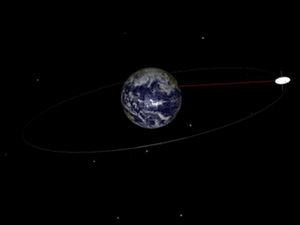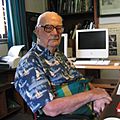Geosynchronous orbit facts for kids
A geosynchronous orbit is a special path that a satellite takes around the Earth. It's like a racetrack in space, about 35,786 kilometers (22,236 miles) above the Earth's surface. What makes it special is that a satellite in this orbit takes exactly 24 hours to go around the Earth once.
This means the satellite stays "in sync" with the Earth's rotation. The word "geo" means Earth, and "synchronous" means happening at the same time. So, a geosynchronous satellite moves at the same speed as the Earth spins.
Contents
What is a Geostationary Orbit?
The most common type of geosynchronous orbit is called a geostationary orbit. Satellites in this orbit are placed directly above the equator. Because they move at the same speed as the Earth spins, and they are above the equator, they appear to stay perfectly still in the sky over one spot on Earth.
This is super useful for many things! For example, communication satellites, like those used for satellite TV or internet, are often in geostationary orbit. If the satellite stayed still, your satellite dish on the ground wouldn't need to move to keep pointing at it.
Other Geosynchronous Orbits
Not all geosynchronous orbits are geostationary. Some satellites in geosynchronous orbits are not directly above the equator. Even though they still take 24 hours to orbit the Earth, they will appear to move in a figure-eight pattern in the sky when viewed from the ground.
This happens because the satellite still orbits around the center of the Earth. So, it spends some time north of the equator and an equal amount of time south of the equator. This makes it look like it's sliding up and down from our view on Earth.
Who Popularized This Idea?
The idea of using geosynchronous orbits for communication was made popular by a famous science fiction writer named Arthur C. Clarke. Because of his work, this special orbit is sometimes called the "Clarke Orbit." His ideas helped inspire the development of many of the satellites we use today.
Images for kids
-
The geosynchronous orbit was popularised by the science fiction author Arthur C. Clarke, and is thus sometimes called the Clarke Orbit.
-
A quasi-zenith satellite orbit
See also
 In Spanish: Órbita geosíncrona para niños
In Spanish: Órbita geosíncrona para niños








